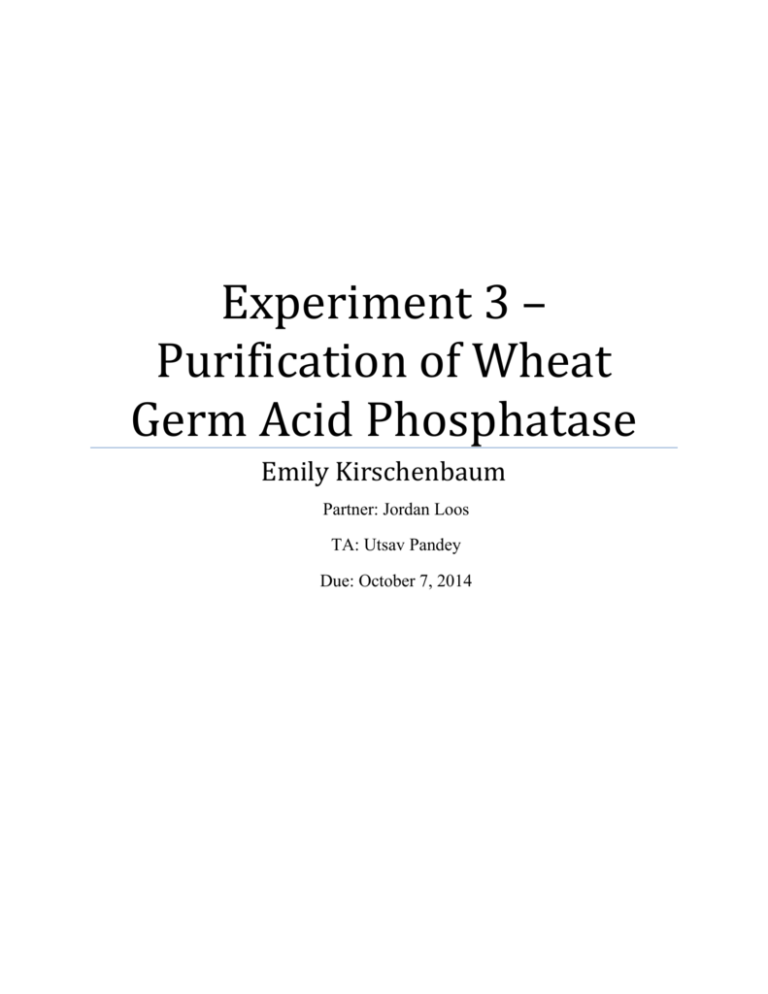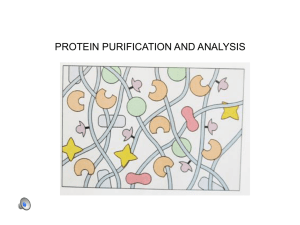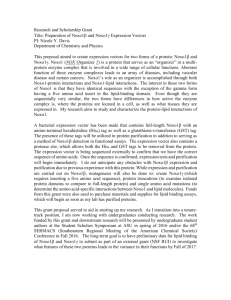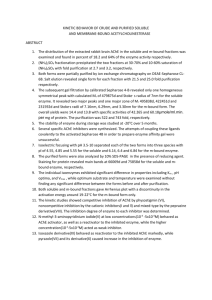Experiment 3 * Purification of Wheat Germ Acid Phosphatase
advertisement

Experiment 3 – Purification of Wheat Germ Acid Phosphatase Emily Kirschenbaum Partner: Jordan Loos TA: Utsav Pandey Due: October 7, 2014 Introduction Proteins are essential to the proper function of living cells. Various chemical reactions, essential to cell function, are occurring within cells at any given moment; without the help of special proteins called enzymes, these reactions would not be able to transpire. Enzymes are unique to specific reactions and they are able to increase reaction rates by up to 1017 times that of uncatalyzed reactions. The use of enzymes spans beyond an individual cell, into the world of medicine, biotechnology, and food. When extracting enzymes from cells, care must be taken to prevent protein denaturing and the impairment of enzyme activity. In this experiment, the enzyme acid phosphatase was extracted from wheat germ and purified. To obtain the enzyme, multiple rounds of centrifugation were used. Centrifugation uses gravitational force to separate molecules based on density. After each round of centrifugation, there is a liquid fraction called supernatant and a solid fraction called pellet. The location of the enzyme depends on the specific stage of the purification process. Aliquots, or small volumes, of solution were collected after each purification step to test for enzyme activity and protein content. These values were used to calculate the specific activity of the enzyme, which is characteristic for each unique enzyme and can be used to analyze the purity. In order to obtain pure enzyme, the following extraction and purification procedure was performed. Acid phosphatase was released into solution by soaking wheat germ in water and allowing the cells to lyse due to increased osmotic pressure. Salt fractionation or “salting out” increases the protein-protein interactions as ammonium sulfate ions attract water molecules. Two stages of salt fractionation were used to remove different unwanted proteins. The 35% ammonium sulfate stage removed unwanted hydrophobic proteins that were present in the pellet after centrifugation. The 57% ammonium sulfate stage removed unwanted hydrophilic proteins in the supernatant and heat treatment at 60ºC was used to reversibly denature acid phosphatase while irreversibly denaturing unwanted proteins. At this point, the desired enzyme had precipitated out into the pellet after centrifugation and water suspension was used to re-solubilize the enzyme for further purification. Methanol fractionation caused the protein to precipitate out during centrifugation, and once again the pellet was suspended in water to re-solubilize the enzyme for the final stage of purification. Dialysis separates small molecules from large molecules in a solution using a semipermeable cellulose membrane. In this case, the small salt ions diffused through the membrane, leaving the pure acid phosphatase behind in the tubing. Results Calculations for amount of solvent added during purification: 1. Amount of ammonium sulfate added during 35% cut (54 mL ammonium sulfate/100 mL fraction) x (amount to add/85 mL fraction) (54/100) x (85) = 45.9 mL of ammonium sulfate 2. Amount of ammonium sulfate added during 57% cut (51 mL ammonium sulfate/100 mL fraction) x (amount to add/126 mL fraction) (51/100) x (126) = 64.26 mL of ammonium sulfate 3. Amount of EDTA added during methanol fractionation (0.11mL EDTA/1 mL fraction) x (amount to add/20 mL fraction) (0.11/1) x (20) = 2.2 mL of EDTA 4. Amount of ammonium sulfate added during methanol fractionation (0.05 mL ammonium sulfate/1 mL fraction) x (amount to add/20 mL fraction) (0.05/1) x (20) = 1.0 mL of ammonium sulfate 5. Amount of methanol added during methanol fractionation (1.75 mL methanol/1 mL fraction) x (amount to add/23.2 mL fraction) (1.75/1) x (23.2) = 40.6 mL of methanol Table I – Enzyme Analysis of Purification Samples Fraction SI SII SIII SIV SV SVI Pure Dilution 1/20 1/20 None 1/50 None 1/100 1/20 Abs. 1 0.455 0.36 0.90 0.43 0.17 0.20 0.65 Abs. 2 0.45 0.31 0.90 0.40 0.14 0.178 0.75 Avg. Abs. 0.455 0.335 0.90 0.415 0.155 0.189 0.70 Concentration (µM) 24.2 17.8 47.9 22.1 8.2 10.1 37.2 Table II – Calculations of Enzyme Activity Fraction SI SII SIII SIV SV SVI Pure [PNP] per time (µmoles/L•min) 4.84 3.56 9.58 4.42 1.64 2.02 7.44 PNP in assay tube (µmoles/min) 0.0363 0.0267 0.07185 0.03315 0.0123 0.01515 0.0558 Activity per enzyme vol.in tube (Units/mL) 0.1815 0.1335 0.35925 0.16575 0.0615 0.07575 0.279 Calculations for Table I and Table II: 1. Concentration of PNP formed (according to Beer’s Law) A = εCl C = A / εl = 0.455/ (18.8x103 L/mol•cm)(1cm) C = 24.2 µM 2. Concentration PNP formed per minute Molarity/ # min for rxn = (mole/L) / min 24.2µM / 5 min = 4.84 µM/min Activity in original aliquot (Units/mL) 3.63 2.67 0.35925 8.2875 0.0615 7.575 5.58 3. Amount of PNP formed per minute (Mole/L) / Min x (L assay in reaction tube) = mole/min (4.84 µM / min) x (0.0075 L) = 0.0363 µmole /min or 0.0363 Units 4. Activity per enzyme volume in tube Units / mL enzyme added = Units/mL 0.0363 Units / 0.2 mL enzyme = 0.1815 Units / mL 5. Activity in original fraction aliquot (Units/mL) x (dilution factor) 0.1815 Units / mL x (20) = 3.63 Units / mL Table III – Purification of Acid Phosphatase from Wheat Germ Tube 1 2 3 4 5 6 BSA std. (mL) 0.0 0.2 0.4 0.6 0.8 1.0 dH2O (mL) 1.0 0.8 0.6 0.4 0.2 0.0 BSA in tube (mg) 0 2 4 6 8 10 Table IV – Analysis of Purification Samples Fraction SI SII SIII SIV SV SVI Pure Dilution 1/10 1/5 None 1/5 None 1/2 None Abs. 1 0.20 0.25 0.205 0.15 0.03 0.07 0.08 *Disregard 0.22 due to error Abs. 2 0.19 0.19 0.19 0.21 0.03 0.1 0.22 * Avg. Abs. 0.195 0.22 0.1975 0.18 0.03 0.085 0.08 Abs. 0 0.085 0.20 0.30 0.39 0.48 Table V – Enzyme Purification of Wheat Germ Acid Phosphatase Fraction Total Vol. measured (mL) SI SII SIII SIV SV SVI Pure 85 126 176 20 56 7 7.5 Total Enzyme Activity (Units) 308.55 336.42 63.228 165.75 3.444 53.025 41.85 Protein (mg/mL) Total Protein (mg) 4.012 4.527 4.064 3.704 0.617 1.749 1.646 341.02 570.40 715.26 74.08 34.55 12.24 12.35 Specific Activity (Units/mg protein) 0.905 0.590 0.088 2.247 0.100 4.332 3.389 Absorbance (at 540nm) Protein Standard Curve for BSA by y = 0.0486x Biuret Method R² = 0.9983 0.6 0.5 0.4 0.3 0.2 0.1 0 0 2 4 6 8 BSA (mg) und in Table III Calculations for Table V: 1. Total Enzyme Activity (Activity/aliquot) x (Volume of collected fraction) (Units/ mL) x (mL of collected fraction) = Units (3.63 Units/ ml) x (85 mL) = 308.55 Units 10 12 Percent Recovery Fold Purification 100% 109% 20.5% 53.7% 1.12% 17.2% 13.6% 1.00 0.65 0.10 2.48 0.11 4.79 3.74 2. Protein y = 0.0486x 0.195 = 0.0486x x = 4.012 mg/mL 3. Total Protein (Protein) x (Volume of collected fraction) (mg/mL) x (mL) = mg (4.012 mg/mL) x (85 mL) = 341.02 mg 4. Specific Activity (Total Enzyme Activity) / (Total Protein) (Units) / (mg protein) = Units/mg protein 308.55 Units / 341.02 mg = 0.905 Units/ mg protein 5. Fold Purification (Specific Activity of fraction) / (Specific Activity of fraction SI) (0.905 Units/mg protein) / (0.905 Units/mg protein) = 1 Discussion The purity of the acid phosphatase was analyzed using total protein, total enzyme activity, and specific activity. In Table V, it is apparent that with each subsequent step in the isolation, the total protein tended to decrease. This decrease in protein was due to the fact that unwanted proteins were removed with each step, in order to obtain a pure sample of the enzyme. In order to test enzyme activity, p-nitrophenylphosphate (PNPP) was used as a substrate for the enzyme. In the reaction, the enzyme caused PNPP to cleave a phosphate group and become pnitrophenol (PNP). The reaction was ended using KOH and PNP turned yellow in the presence of base. Visually, the higher the intensity of the yellow color in the fraction, the higher the concentration of product and thus the higher the enzyme activity within the fraction. With each step of the isolation, the total enzyme activity tended to decrease. Enzyme activity is an indication that there is functional enzyme present in the sample, but it does not provide insight into the amount of enzyme or its purity. Therefore, the decrease in enzyme activity cannot be used to make a claim about purity. Successful purification is indicated by an increase in the specific activity from one purification step to the next. With each subsequent step of the isolation procedure, the specific activity tends to decrease. There is an increase in specific activity from fraction SIII to SIV and SV to SVI. These specific activity increases indicate that both methanol fractionation and dialysis were successful at purifying acid phosphatase. Dialysis was the best purification step in terms of increasing specific activity. When reporting the values for protein total and total enzyme activity, it was important to take any dilutions made into consideration. This is necessary to report what occurred in the entire fraction. If one was to publish the specific activity of a pure novel protein fungicide without considering the 1/25 dilution made during protein content determination, the value would not accurately represent the fungicide as a whole. The specific activity reported would be 25 times its actual value and should therefore be adjusted to represent the whole fungicide accurately. Each step of the purification process was not equal in effectiveness. The step in the purification that was the worst in terms of loss of units of enzyme was the first water suspension after the 57% ammonium sulfate cut and heat treatment. The heat treatment is able to reversibly denature acid phosphatase, so that is not likely to be the reason for the loss in enzyme units. However, during the transfer of the sample from heat treatment to the ice bath for cooling, water flooded the sample from the ice bath. This unintentional dilution could have negatively impacted the enzyme in solution. In general, the enzyme purification was the least effective during the water suspension stages. Acid phosphatase is a water-soluble enzyme, so this step was able to extract the enzyme from the pellet but other water soluble molecules could have been incorporated. If a different solvent was used, maybe the loss wouldn’t be so significant. To protect the integrity of the enzyme, the conditions within the experiment must be highly regulated. It is necessary to maintain low temperatures and minimize foaming during purification because these precautionary strategies prevent protein from denaturing. The results obtained in this experiment can be compared to a similar experiment involving the purification of acid phosphatase. The specific activity steadily increases with each subsequent step of the purification process (Cooper, 1977). The results from this experiment indicate successful purification of the enzyme due to the increase in specific activity from one step to the next. According to Table V, the specific activity tends to decrease overall. Only two purification steps, methanol fractionation and dialysis, indicated successful purification of acid phosphatase. When comparing the results from the two experiments, common ground was found with respect to the purifications step which displayed the highest increase in specific activity: dialysis. The pure fraction is not 100% acid phosphatase. The most obvious indicator of this fact is the solid pellet found at the bottom of the tube. The enzyme was extracted and purified following the experimental steps, but the final pure fraction contains other molecules besides the enzyme. Affinity chromatography is one technique that could be used to truly purify the enzyme. This technique involves running the enzyme through a column which contains a competitive inhibitor which is specific to the enzyme in question. All the proteins that do not have an affinity for this inhibitor would pass through the column, leaving the desired enzyme within the column. This enzyme is free of any unwanted proteins or molecules, and therefore the enzyme would be considered pure (Cuatrecasas, et al, 1968). Bibliography Cuatrecasas P, Wilchek M, Anfinsen CB. Selective enzyme purification by affinity chromatography.Proc Natl Acad Sci USA. 1968;61(2):636–643. Padala, V.R. BMB 212 Fall 2014 Manual, pp. 23-38. T.G. Cooper, The Tools of Biochemistry, Wiley, New York, 1977, pp. 402-404.








